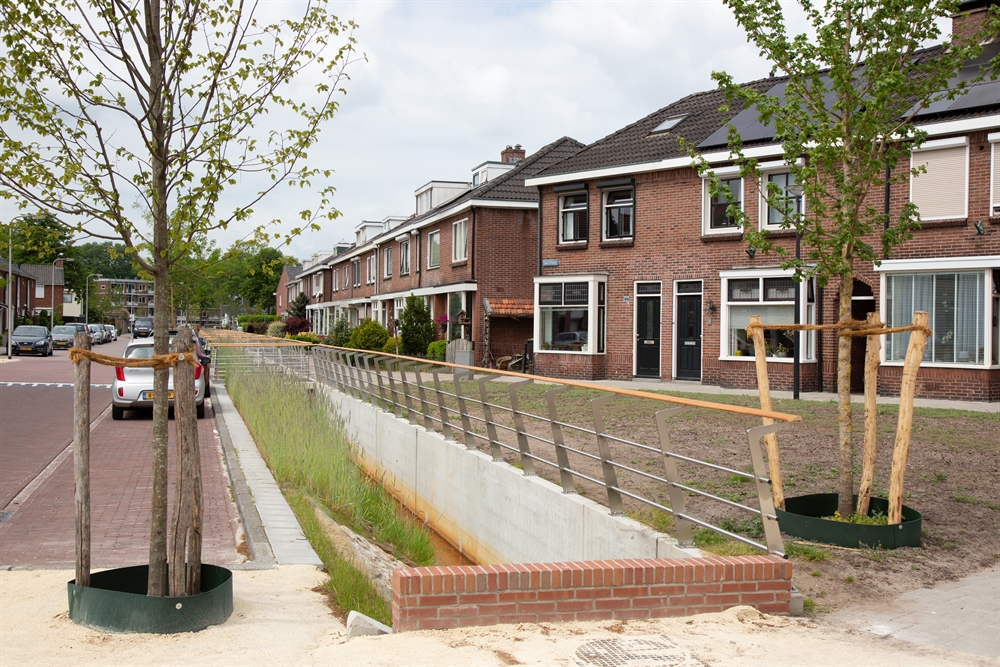Enschede restores former urban brook
Enschede is highly prone to waterlogging and has already conducted multiple stress tests and risk dialogues. According to the 2014 stress test, the risk of waterlogging is highest in the Pathmos and Stadsveld neighbourhoods. These neighbourhoods feature narrow streets, with extensive pavement and little greenery. Torrential rain leaves water on the streets, which occasionally flows into buildings. The municipality intends to combat waterlogging by restoring one of the brooks that used to run through the city of Enschede.
Enschede has been selected as an implementation pilot. In 2020, the city received a grant from the national government in the purview of the Urban Brook. This grant enabled the municipality to give impetus to the construction of the Urban Brook in Pathmos and Stadsveld. The pilot ran until mid-2021.
Why is Enschede prone to waterlogging?
Enschede is situated on a lateral moraine and consequently features differences in elevation of up to 44 metres. During severe downpours, rainwater flows to the lowest elevations, where it causes waterlogging. In addition, 82 brooks used to crisscross the city. Most of these brooks have disappeared as a result of the increase in buildings and pavement in the city. This hampers rainwater drainage. Furthermore, the layers of loam in the moraine subsoil prevent the water from infiltrating into the ground. These layers of loam are not permeable to water.

Fotograaf: Ruud van der Linden
What does the new Urban Brook look like?
The Urban Brook extends over a total length of 2.2 kilometres and has been constructed in three phases. The third and last section - Elferinksweg – was by far the most complex. In the Pathmos and Stadsveld neighbourhoods, the municipality has restored part of the old brook structure, in collaboration with the Vechtstromen district water board. In addition to rainwater, the brook also discharges excess groundwater: the neighbourhoods are faced with extremely high groundwater levels, and via a drainage and infiltration system this water will also end up in the brook. Thus, groundwater is discharged during wet periods and supplemented in periods of drought. Additional greenery and trees along the brooks boost the neighbourhoods’ heat resilience and enhance biodiversity. The municipality joined forces with a construction team to ensure an optimum balance between project budget, project goals, quality, societal acceptance, and social costs.

Fotograaf: Ruud van der Linden
Municipality involved residents in design and construction
The municipality has noticed the importance of intensive communication with residents and of giving them a say in the measures to combat waterlogging. It has involved residents in different phases of the project. For example, residents participated in design sessions to help shape the Stadsbeek. And the 'BouwApp' kept them informed of the work. In addition, a neighbourhood concierge visited residents to answer their questions. The discussions with residents have garnered more support and enthusiasm for the construction of the Urban Brook.
Research University of Twente
During and after the last part of the implementation phase, the University of Twente has researched to what extent the involvement of residents in the construction of the Stadsbeek affects their motivation to make their own garden and home more climate proof. In the first report (pdf, 683 kB) of this research the researchers listed, categorised and visualised the various participation measures. Afterwards, they conducted a survey among the residents. In the second report (pdf, 1.9 MB), they discuss the results of this survey.
Municipality encourages residents to climate-proof their own garden
In addition to the construction of the Urban Brook, the municipality is encouraging residents and housing corporations to climate-proof their gardens. In September 2020, it has launched a campaign to this effect. Many residents of these neighbourhoods live on a fairly low income. How can you motivate them to climate-proof their environment? In the campaign, the municipality is utilising several initiatives. Some examples:
- the urban groenblauwenschede.nl campaign;
- a study conducted by some 200 students of the Saxion University of Applied Sciences Communication programme into ways to encourage residents to take climate-adaptive measures;
- collaboration with the 1Twente regional public broadcasting service: water.1twente.nl.
Contact person
Rik Meijer
Gemeente Enschede
r.meijer@enschede.nl
